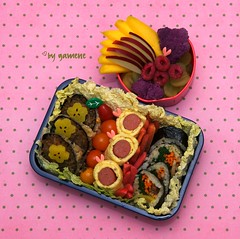 I like to write practical advice. But sometimes, aesthetics matter. My mother made a special pint of ensuring that the colors and textures of teach meal were harmonious. She also had all kinds of little tricks to lay out the food attractively. While I am much more laid back, I still use her tricks when guests come. You’ll rarely catch me serving food out of the storage container or package, even thought it means washing an extra bowl.
I like to write practical advice. But sometimes, aesthetics matter. My mother made a special pint of ensuring that the colors and textures of teach meal were harmonious. She also had all kinds of little tricks to lay out the food attractively. While I am much more laid back, I still use her tricks when guests come. You’ll rarely catch me serving food out of the storage container or package, even thought it means washing an extra bowl.
Let’s start with serving pieces. Since these are a popular hostess gift, you probably have a few. If not, keep your eye out in bazaars, garage sales and even grocery stores, which usually have a few pieces marked down. Look for a few matching finger bowls, or a platter with several small compartments. Then you can place salads or raw vegetables, sauces or olives in each of the bowls or compartments.
Choose the right size bowl for the amount or it will look skimpy. With small bowls you can offer a variety with less space, and fill as needed. If you are serving a crowd offer more than one bowl of each item. Also, place the food neatly into the bowl and mold it into shape if you can. Leaving scraps on the upper edges of the bowl is unattractive.
Garnishes
Decorate your food with a contrasting color, flavor or texture. Always use fresh and colorful ingredients or you will defeat the purpose. Avoid decorating with fish, meat or cheese as they will shorten the life of the garnished food.
Line your food with vegetables. For instance, place a few lettuce leaves on a plate and add cottage cheese, egg salad or tuna salad. Or cut off the top of a pepper and fill it with chumus. Other example are a scooped out loaf of bread for soup, or a watermelon rind for fruit salad.
Here are some items I often use for garnishing food, along with examples. But don’t be limited—use your imagination.
- Olives. Example: Tuna salad
- Pickle slices. Example: Potato salad.
- Nuts or seeds. Example: Paté.
- Ground spices. Example: Paprika on egg salad or cream cheese.
- Grated or thinly sliced fresh vegetables. Example: Radish for a soup garnish. Also try carrots, tomatoes, peppers, onions, cucumbers, or kohlrabi.
- Olive oil. Example: Make a well in your chumus and pour in a teaspoon or two.
- Herbs. Example: Chop and add to soup just before serving. Or use mint leaves for cooked fruit.
- Lemon or orange slices. Example: Tuna salad or a pitcher of water.
It’s a good idea to keep jars of olives, pickles, and chickpeas on hand in your pantry for unexpected company, along with seeds and nuts in the freezer. And I generally have carrots or citrus fruit available, since they keep fairly well. You can use them as garnishes, or serve them in a small bowl or plate alongside your cooked food.
If you want something a little extra you can try reader Miriam’s tip for making rose buds out of radishes: Cut off the point, make a few half cuts, like a hexagon, and put it in cold water (maybe with salt) to open up.
What are your favorite tips for serving food attractively?
You may also enjoy:
Tips to Stretch Food for Unexpected Company

Nutrition and colors *can* work together, as long as one isn’t depending on food coloring for the color. You get different nutrients from vegetables of different colors, so having purple cabbage, orange squash, dark green parsley and bright red tomatoes all provide different nutrients and make a pretty table, too.
Love this post idea in general. I’m thinking of quoting half your text (with credit, of course) and lining up about 10 different photos to go with your comments. Maybe.
Leora, yes, the lack of photos is blatant!
Great suggestions! Decoration is something I tend to forget; thanks for writing about it.